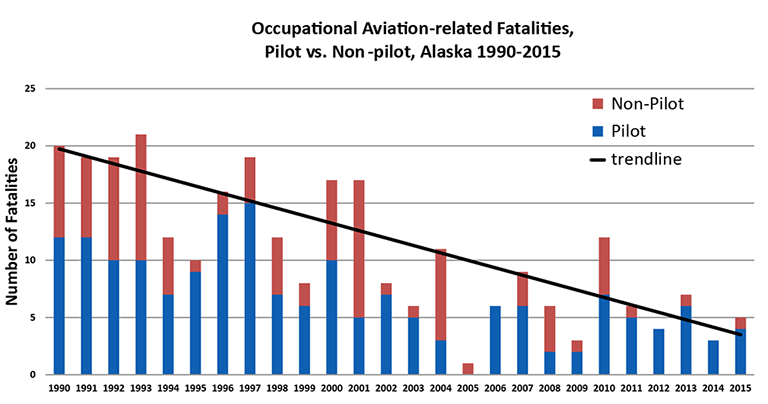Intermediate Outcomes

Graph showing Occupational Aviation-related Fatalities, Pilot versus Non-pilot, Alaska 1990-2015.
The NIOSH Aviation Safety Research Program is dedicated to providing our stakeholders high quality, relevant information that has direct impact on aviation safety. Our efforts over the past decades have helped to reduce aviation accidents, and thus reduce aviation-related fatalities among pilots and other workers. The program’s research has been used by the industry, government agencies, and aviation safety advocates to inform policy decisions and, educate workers about the safety hazards and solutions evaluated in the research. These intermediate outcomes provide examples of how NIOSH research is translated to practice by our stakeholders.
Impacts made by the NIOSH Aviation Safety Research Program:
- NIOSH created a fatigue prevention training program to help commercial pilots in Alaska increase their awareness and recognize fatigue in themselves and others, understand how to mitigate fatigue, and to improve their sleep. The training can be used by commercial aviation operators, directors of safety, the aviation industry, and general aviation pilots as well.
- As part of the Mat-Su Mid-Air Collision Avoidance Working Group, formed after three mid-air collisions in 2011, NIOSH researchers were responsible for analyzing data and providing updates. Recommendations from the group were submitted to the Federal Aviation Administration and were accepted; they went into effect May 2014.
- NIOSH led the Project Evaluation Team for the evaluation of the cue-based training product developed for "flight-seeing" tour pilots in Southeast Alaska to help prevent controlled flight into terrain accidents. This simulator training tool provides built-in cues that allow pilots to test their decision making skills in deteriorating weather conditions.
- NIOSH was a partner in the Alaska Interagency Aviation Safety Initiative, which was funded by the US Congress in 2000 and focused on improving safety in commuter and air taxi operations in Alaska. NIOSH conducted a statewide survey of commuter and air taxi operators and pilots, and their research findings provided identification of risk factors. Industry, non-governmental safety organizations, and government agencies were able to work together in a multi-faceted public health approach and reduce the number of fatal crashes among air taxi and commuter operations in Alaska by 53% between 2000-2009 and the prior decade. Please see our fact sheet or this journal article.
- As a result of nine fatalities and ten nonfatal injuries that occurred during helicopter logging operations in southeastern Alaska from January 1992 through June 1993, NIOSH convened a working group which recommended injury prevention interventions on the Prevention of Occupational Traumatic Injuries and sponsored two helicopter logging safety workshops. As a result, there were no logging helicopter crashes or injuries in Alaska from 1994 through 1995, and a single crash, resulting in one pilot fatality and one pilot serious nonfatal injury, in 1996. For additional information, please see our publication: Epidemiology and Prevention of Helicopter External Load Accidents.
- Page last reviewed: January 4, 2017
- Page last updated: January 4, 2017
- Content source:
- National Institute for Occupational Safety and Health Office of the Director


 ShareCompartir
ShareCompartir